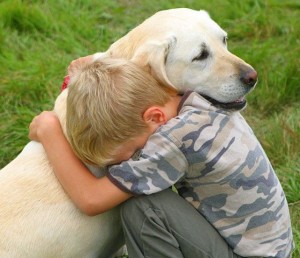 The loss of a pet is often a child’s first experience with death and because it is painful, parents often wish to protect them from it. Not talking about it, however, can make the grief process even more difficult. Parents need support and reassurance that a decision to include children in the end of life process of a beloved pet can be a rewarding and positive experience.
The loss of a pet is often a child’s first experience with death and because it is painful, parents often wish to protect them from it. Not talking about it, however, can make the grief process even more difficult. Parents need support and reassurance that a decision to include children in the end of life process of a beloved pet can be a rewarding and positive experience.
Explaining death
When speaking with children about the death it is extremely helpful to use clear, concrete and simple language. Avoid using euphemisms like “put down” or “put to sleep” which can leave children with confusion around what it means to rest or sleep.
Children understand when something is wrong even if it is unspoken. Often a pet is ill for some time before their eventual death, which is a good time to begin the discussion of what is happening to the pet’s body. This may also be a good time to find a children’s book about pet loss as a way of beginning that conversation. An extensive bibliography listing several good choices is available at this link.
Once the conversation begins children will have questions. It is important to answer all the questions that come up as honestly and plainly as you can, even if they are silly, difficult or complicated. This is also a good time to find a children’s book that can answer some of the specific questions they have about death. It is also important to be honest when there are things you do not know or cannot be answered. Death can be a mysterious process for adults and children alike.
Decisions
If you are preparing for a euthanasia appointment it is important to explain the process and then give your child options for how they would like to be involved. They might decide they would like to be present during the appointment or maybe they would like to be in an adjacent room with a supportive adult and then visit with their pet’s remains after the appointment. On the other hand, they might only wish to be involved in the memorialization or burial of their pet.
Support your child in a non-judgmental way as they experience their grief. Ask them about how they are feeling and ask them if they would like to talk about that—actively listen to what they express and mirror back to them what you hear them say using their own words.
Grief process
It is often helpful to children to process their grief in non-verbal ways. Providing some art materials can be very effective – you may help them identify something important they are expressing and ask them if they would like to make a picture of it. Creating a scrapbook can also be a helpful project.
Memorialization is another task that could have non-verbal or physical components. Offer to let them participate in the decision-making process. Where will Bailey be buried? What will we do with her ashes?
There is no defined length of time a grieving process will take. Children may recall happy and sad memories of their pet well after their pet has died—allow the space necessary for them to express any and all of those memories in an ongoing way.
Taking breaks
Grief can be a strenuous endeavor. It impacts mind, body, and spirit. There will be ups and downs related to the exertion of grieving, coupled with a need for distraction. It is helpful to the grieving process to take breaks, particularly if they involve something fun and especially if they include laughter.
More information
If you have additional questions or concerns about your unique situation, feel free to speak with us. We have licensed counselors on staff daily, available at 612-354-8500 Mon-Fri, 8:00 AM-6:00 PM and Sat/Sun 8:00 AM-4:00 PM. There is also an excellent article available on this topic at a favorite website of ours, veterinarywisdom.com.
Click here for a FREE printable version of this article: Children and Pet Loss

Pingback: A letter for your child's teacher | MN Pets